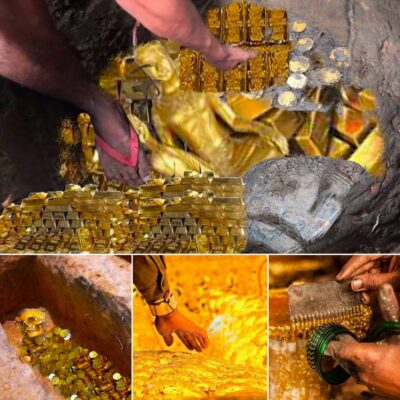Standard-sized fruit trees are long-lived specimens that can become quite massive in time. Dwarf fruit trees, by contrast, are much smaller in stature. Typically reaching around 8 to 10 feet tall and wide, these miniature beauties will provide an abundance of full-sized fruit each season but are much easier to manage and care for than their towering counterparts.
Whether you wish to grow a tiny orchard or a single fruit tree, dwarfing varieties are a clever solution for growing fresh fruit in small spaces. Here are dwarf fruit trees for high yields in small gardens that you should plant.
1. Red Delicious Apple (Malus domestica ‘Red Delicious’)

There’s a staggering amount of choice in apple trees, with more than 2,500 different varieties cultivated in North America alone.
Red Delicious is a popular pick that blooms with pinkish-white flowers in mid-spring. In autumn, it bears sweet and juicy apples that are excellent for fresh eating and cooking. The fruit has a good storage life and will keep up to six months in the fridge.
It’s important to note that apple trees are not self-pollinating
Compatible pollinators for Red Delicious include other mid-season bloomers such as Golden Delicious, Gala, and Honeycrisp.
Alternatively, you can save on yard space by choosing a multi-grafted apple tree with two (or more) compatible scions.
- Hardiness zone: 5 to 8
- Dwarf size: 10 feet tall and wide
- Chill hours: 700 to 800
- Self-fertile? No
2. Elberta Peach (Prunus persica ‘Elberta’)

An heirloom variety that originated in Georgia, Elberta peaches are yellow freestone fruits that finish with a blush of reddish pink. These fuzzy peaches are large, juicy, and sweet – ideal for eating, freezing, canning, and jam-making.
The tree is a show stopper in early to mid-spring when masses of fragrant pink blossoms adorn its leafless branches.

As the season wears on, fruits are ripe and ready for picking from late July to early August.

Elberta peach trees are self-fertile but will benefit from a second peach tree nearby to cross-pollinate with. Keeping at least two peach trees will vastly improve the production of fruit.
To keep your peach tree healthy and productive, annual pruning is an absolute must. This is because peach trees will only bloom and bear fruit on branches that are at least one year old.
Pruning the tree back by as much as 40% each year is necessary to simulate new growth for the following season. Older wood will eventually stop producing flower buds (and thus, fruit) and needs to be cut back to make way for new fruiting branches.
- Hardiness zone: 5 to 9
- Dwarf size: 8 to 10 feet tall and wide
- Chill hours: 800 to 950
- Self-fertile? Yes
3. Santa Rosa Plum (Prunus salicna ‘Santa Rosa’)

A Japanese plum, Santa Rosa is a self-pollinating plum tree that is stunning in spring and a delicious provider come July.
Santa Rosa is an early and prolific bloomer, bearing sweet and fragrant white blossoms in tight clusters along every branch and stem. The fruit is large, red to purple in color, and good for eating, canning, and cooking.
It naturally grows in a rounded canopy and requires minimal pruning to maintain its shape and allow for sunlight to reach the center of the tree.
- Hardiness zone: 5 to 9
- Dwarf size: 10 to 12 feet tall and wide
- Chill hours: 300 to 500
- Self-fertile? Yes
4. Black Tartarian Cherry (Prunus avium ‘Black Tartarian’)

Black Tartarian cherries are tender and plump with a rich, full-bodied flavor.
The 1-inch, heart-shaped, purplish-black drupes are perfect for fresh-eating since the inner pit is smooth and separates easily from the flesh. Black Tartarian also does well in canning and preserve making.

Putting out a glorious show in early to mid-spring, the white colored blossoms fill the air with a sweet scent. By mid-summer, ripe cherries arrive in clusters along the branches.
Like all sweet cherry cultivars, Black Tartarian is not self-fertile and needs a second cherry species in order to produce fruit. Plant it along with similar early blooming varieties like Bing, Stella, and Ranier.
- Hardiness zone: 5 to 8
- Dwarf size: 8 to 14 feet tall and wide
- Chill hours: 700 to 800
- Self-fertile? No
5. Washington Navel Orange (Citrus sinensis ‘Washington’)

Best for fresh eating, Washington Navel oranges are seedless, easy to peel, and supremely flavorful fruits.
The dwarf version grows to be about half the standard size, but can be carefully pruned to a petite 3 feet in height.
An evergreen tree, Washington Navel orange has attractive elliptical leaves that give off a wonderful fragrance year-round. In spring, clusters of waxy, white blossoms appear along the branches.
Like all orange trees, Washington Navel loves warmth and sunlight. It grows best in temperatures between 70°F and 90°F (21°C and 32°C).
In frost-free regions, it can be planted directly in the ground. Gardeners in northern climates can grow it in containers and bring it indoors as soon as temperatures dip to 55°F (13°C) and below.
- Hardiness zone: 9 to 10
- Dwarf Size: 6 to 8 feet tall and wide
- Self-fertile? Yes
6. Celeste Fig (Fiscus carica ‘Celeste’)

Fig trees are native to the warm and temperate regions of the Mediterranean and typically grow best in USDA zones 8 to 10.
Celeste is a much more cold hardy cultivar that can be planted outdoors to zone 6. At the cooler end of its hardiness range, it requires a sheltered location and deep mulching to survive winter temperatures of 15°F (-9°C) and lower.
Compact too, it’s a good candidate for container gardens and can be hauled indoors to overwinter in colder areas.
Maturing into a handsome multi-branched tree with silver-grey bark and deeply lobed leaves, Celeste bears small, green, and inconspicuous flowers in spring. Although it’s less showy than other fruit trees when in bloom, this little tree will provide loads of figs in late summer.
Celeste figs are small to medium in size, are bronzy-purplish in color, and have a very rich and sweet flavor. These are delectable eaten fresh off the tree or prepped in jams, preserves, and pastries.
- Hardiness zone: 6 to 10
- Dwarf size: 7 to 10 feet tall and wide
- Chilling hours: 100
- Self-fertile? Yes
7. Ice Cream Mango (Mangifera indica ‘Ice Cream’)

Normally, mango trees take up a ton of space and can grow to more than 100 feet in height. But dwarfed varieties, like Ice Cream, will keep your mango tree to a much more manageable size.
Ice Cream mango can be trained and pruned to only six feet tall. Known as a “condo mango” it is easily grown in containers and set out on a balcony or patio.
Although mango trees are better suited to warm, tropical climates, container-grown mangos can be placed outside in spring and summer and brought back inside before temperatures reach 40°F (4°C).
Ice Cream mangos are sweet, rich, and creamy. The fiberless fruit starts out green and will ripen to yellow as the weather heats up in June and July.
- Hardiness zone: 9 to 11
- Dwarf size: 6 to 8 feet tall and 4 feet wide
- Self-fertile? Yes
8. Black Mulberry (Morus nigra)

Although it’s often referred to as a bush thanks to its naturally shrubby habit, mulberry can be trained to grow into classic single trunk trees with a dense canopy.
The standard size matures to around 40 feet tall and wide but the dwarfed version can be kept under 10 feet.
Because Black Mulberry produces its delicious fruit on both old and new wood, it can be pruned back each season after fruiting has finished in autumn. This is how you can keep it to a tiny 2-feet.
Whether grown as a tree or shrub, Black Mulberry is a lovely specimen with serrate and leathery green leaves. Inconspicuous green catkins in spring turn to masses to purplish-black berries in summer.
Black mulberry fruit is considered to be the tastiest of all the mulberry species. The fruits look like oblong blackberries, each about one inch long. Juicy and sweet, these are delightful eaten fresh but are equally wonderful as jam, syrup, and wine.
- Hardiness zone: 5 to 9
- Dwarf size: 2 to 10 feet tall and wide
- Chilling hours: 200 to 400
- Self-fertile? Yes
Thank you for spending time to see this article of Ideassimple about 8 Dwarf Fruit Trees For High Yields In Small Gardens That You Should Plant. Please give us a like, comment or share if you find the article good and meaningful. Have a good day!











